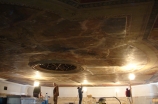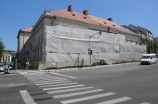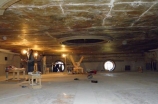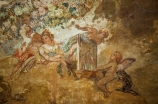Guests Online
Visitors from 06.02.2014
Rehabilitation project
Built in the nineteenth century, over several stages, the Transylvania building from Zalau is undoubtedly the most imposing of the protected monuments from Zalau. Fronting the monument Wesselenyi, also on the list of historical monuments, a park and a fountain with cupids, the Transylvania building overlooks the historical center of the city, but requires extensive rehabilitation works.
Zalau Municipality started the rehabilitation works in 2005, when a corner of the building was in danger of collapse. Because the intervention was urgent at that time and the financial resources were scare, the municipality was forced to divide the rehabilitation over several years, with different funding sources (local budget, credit, grants).
The final stage of the rehabilitation was started in March 2009, with the submission of the project "Rehabilitation of the monument Transylvania Building from Zalau" at the North West Regional Development Agency, in order to obtain grants.
The financing contract was signed in October 2011, and the project will be completed in April 2014.
This is one of the projects financed by the Regional Operational Program, Priority Axis 1 - Support the sustainable development of cities, urban growth poles, area of intervention 1.1-intergrate Urban Development Plans, Sub-area: urban centers.
The estimated value of the project is 10,119,924.33, and funding sources are the European Regional Development Fund, the national budget and local budget.
The restoration of Transylvania Building occurs in a context of cultural heritage and cultural activities revival, and of thematic tourism development. Currently there are several projects in various stages that may contribute directly or indirectly to the growth and development of tourism in Zalau in Salaj:
- restoration of several heritage buildings in the city that will essentially improve the image of the historic center
- developing a circuit of wooden churches is about to become a concrete activity both because Salaj County Council's initiative to promote the project in Axis 5.1, but also due to the rehabilitation projects of wooden churches in Salaj county financed by the Ministry of Culture
- developing a circuit of Roman camps, project of Salaj County Council, also financed through European grants; this project is backed up by the Zalau Porolissum Roman Festival Municipality Zalau, an event organized every year by Zalau Municipality and that can become part of a network of similar events in Europe and the world
- development of road infrastructure and increased accessibility will improve the chances for the city to become a suitable place for organizing regional events
- the possibility to develop other types of tourism in the county and around the city, namely recreational and sports tourism, if we consider the potential of Meses Mountains, 'green' or eco-tourism (the Botanical Gardens from Jibou which tends to be an excellent touristic attraction, natural protected areas), rural tourism and tourism focused on traditions etc.
- developing cultural activities that will bring tourists in the city, some of these activities being held in Transylvania Building, considering that the interest of locals for such events is growing and there is an active "core" of cultural institutions and organizations wanting to organize regional events.
The rehabilitation works began in March 2012 and were completed in November 2013. The project financed by the Regional Operational Program was targeting the "C" section of the building (the aisle fronting Gheorghe Doja str. and the Iuliu Maniu Square). This aisle was entirely restored from the roof to the coating, on the inside and on the outside; all the appliances and mains connections, interior and exterior woodwork, wrought iron elements, bas-reliefs on the facade were all replaces or restored.
The entire building was equipped with alarm system in case of fire and air conditioned. An elevator and a stairs lift for easy access to people with motor difficulties.
One of the objectives of the project is the introduction of the building in the tourist circuit. In order to achieve that, the former theater hall was transformed into a multifunctional room. The restoration of the ceiling painting from this room was, as the restoration expert said it, "a technical and stylistic challenge both in terms of the methodology of execution, as in compositional point of view". The painting covers an area of approx. 300 m2; its refined, sophisticated concept leads us to the Austrian palaces from the second part of the 19th century. Besides the construction and renovation works, the multifunctional room will be equipped with appropriate furniture for organizing shows and exhibitions, a sound system adequate to conferences, and a security system. At the end of the project, the multifunctional room will host the first event, the inauguration of a series we hope as long as is possible.
The outside of the building has not been neglected. The pavements, road access and the parting were rehabilitated, also the patios and green spaces. The entire building is illuminated by lighting system, designed to highlight the building. The park in front of Transylvania Building was equipped with benches and bins to fit the architecture of the area. Behind the building a public toilet was built.
The rehabilitation of the Transylvania Building is part of a broader approach to develop Zalau municipality as a regional administrative and logistical center and as a friendly city to its inhabitants; the central area of the city is the "engine" of this vision. Together with other projects for the rehabilitation of historical buildings, the Transylvania Building will create the premises for Zalau transformation according to its vision statement: "imposing Zalau as logistical and administrative center of the North West Region, on the one hand, and on the other hand as the friendliest city for its inhabitants. Zalau should become again the gateway to Transylvania."
 www.inforegio.ro
www.inforegio.ro
Investing in your future! Project selected in the Regional Operational Programme and co-funded by the European Union through the European Regional Development Fund. This report does not necessarily reflect the official position of the European Union or the Romanian Government. For detailed information about other programs financed by the European Union, please visit www.fonduri-ue.ro














